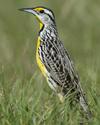Week Six - Thrushes, Blackbirds, Corvids, and Mimics Flashcards
(19 cards)

Gray Catbird - Mimidae
Very distinct and meowy call, with some whistles in it.
All grey with a strong black cap. Distinctive.

Brown Thrasher - Mimidae
Deep, down-curved bill.
Looks almost like a thrush, but it’s brown is a lot “brighter”.
Two distinct notes at the beginning of the call, and calls also tend to be in pairs of notes.
Super aggressive during the breeding season…known to draw blood!

Northern Mockingbird - Mimidae
White breast, black wings and tail, with an orange eye.
Extremely talented mimics, to the point where discerning reality is difficult.

Eastern Bluebird - Turdidae
Rusty breast, blue back.
Insectivorous and talented at catching bugs, typically watching them on the tips of branches.
Sounds not as flutey as other thrushes.

Veery - Turdidae
The clearest breast of the “confusing thrushes”. Likes heavily wooded areas.
Tan breash wash with light spotting.
An almost ethereal, beautiful call. Wonderful.

Swainson’s Thrush - Turdidae
More spotting on breast than Veery, tan wash on throat, but has a distinct white eyering.
Spotting fades as it gets towards the flank.

Gray-cheeked Thrush - Turdidae
Has an interesting, grey cheek patch!
Spotting, but it has NO tan wash out of the 4 confusing thrushes.
Duller brown back than Swainson’s, no eyering.

Hermit Thrush - Turdidae
Rufous tail, dull brown back.
Breast spotting farther, and MUCH more distinct than any of the other confusing thrushes,
Weird dying flute noise, which tapers at the end of the call.
One, longer note at the beginning of the call.
Wood Thrush - Turdidae

The most distinctive spotting! Rufous head and back, and very secretive.
Has almost robin-y notes. Short muttering at the beginning, ascending trill, and then a descending buzzing.

Bobolink - Icteridae
Stupid hair, looks a bit like an idiot
Kind of a white wing
Sounds like a normal R2D2.
Cheerful, bubbling, jangly notes on wildly different pitches.

Red-Winged Blackbird - Icteridae
Red pauldrons on the male, but the females are all brown, streaky, and with a white supercilium.
They have a very distinctive habitt.
Iconic call, “kon-ka-REEEEEEEE”, a harsh whistle trill too.

Eastern Meadownlark - Icteridae
Black bird, kinda like a Dickcissel.
Yellow lores with a mottled back.
Distinguished from the eastern through the clear like dinguishing the yellow neck from the yellow on the head.
Melodic call of “first-spring-of-the-year!” Higher and learer than western.

Western Meadowlark - Icteridae
Duller Black, vaguer yellow transition from neck to head.
Distinct call, more grabled, deeper, and nothing like the eastern. Blackbird-like but more more musical.

Yellow-headed Blackbird
Yellow head, black beak, and likes prairies + marshes.
Sounds like a very loud, angry R2D2, or someone playing a trombone while being strangled. Extremely harsh and unmusical.

Rusty Blackbird
Pale, yellow eye.
Sounds like a liquidy, rusty hinge.

Common Grackle - Icteridae
Large, iridescent, and a super duper long tail.
A long, heavy bill.
Iridescence is limited to head, uniform bronze on the body.
Very harsh, toneless, and dry calls.

Brown-headed Cowbird
Males have a brown head and a glossy body.
Females are all brown, plain. Whitish throat, ad usually finely streaked.
Liquid squeaky call, som chattery calls.

Orchard Oriole
Less bright than Baltimore, and has faint wing barring.
Smaller than other orioles and sometimes mistaken for a warbler.
Baltimore Oriole

Very bright, super orange! Brightest on breast.
Has tooty notes, almost robinlike.
Sounds almost forlorn, “oh….kay!”, clean whistle quality.


